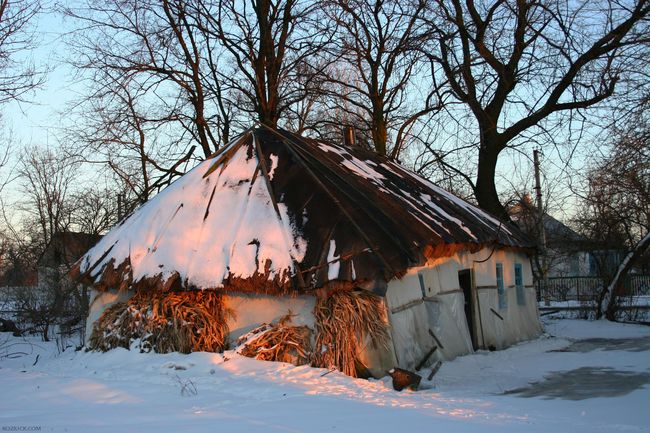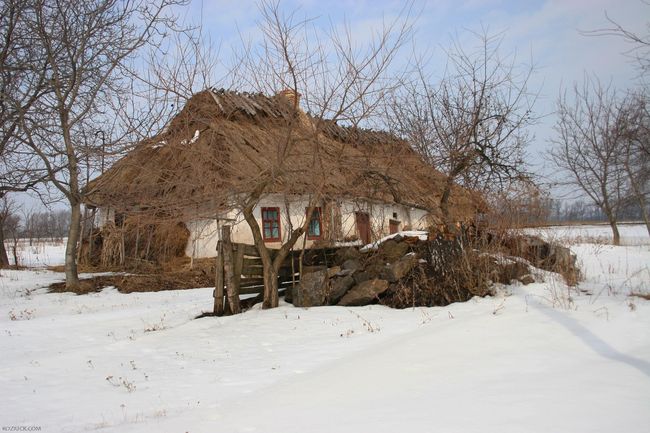Volodymyr Koziuk has been traveling across villages for 20 years in search of old thatched houses. At first he painted and then began to photograph them. Some people were surprised – who needs this? But Volodymyr went on because he understood that the traditional thatched house as an item of Ukrainians’ everyday life would soon vanish and only some museum exhibits would remain behind. So, it is books, canvases, and photographs that will play the honorary role of passing reminiscences to future generations. When the artist wrote in late 2016 about an intention to publish the almanac “Thatched House” and posted his pictures of old mud-walled huts in the Web, this drew a wide response. As Den wrote then (№220-221, (2016) https://day.kyiv.ua/uk/article/cuspilstvo/u-ciy-hati-narodylas-ukrayina), 7,000 users reposted his publication, and the number of rapturous and grateful comments was incalculable, even though very few people have ever shown interest in or just seen these white squat-shaped houses in small Ukrainian villages.
“I traveled across at least 800 villages. I used to get to them on regular buses and by bicycle, later I bought a car, only to break it on bumpy rural roads,” the artist says, smiling. “I was looking everywhere for old thatched houses, asking at village councils about them. I was usually told: ‘No, we haven’t any.’ But it often happened like this: you walk through the village, and it suddenly emerges from behind the hill – an old but very beautiful one. I first feasted my eyes on it, trying to choose a good place to take a picture, and only then worked. I found most of the survived huts in Murovani Kurylivtsi raion. Among them were 150-year-old mud houses. The house of a woman named Nastia in the village of Verbovets was in the best condition, plus a wonderful landscape around. I still remember that place and day.”

Koziuk once showed his photos of thatched houses to Vinnytsia-based architect Liudmyla Denysova. “Oh, they still exist!” she said in surprise. Yes, they still existed at the time but have almost all disappeared now. It is after this conversation that Volodymyr hit upon an idea to gather his picture in an almanac in order to show everybody what you can no longer see because thatched houses are gone and their owners have long passed away. Now you can only see them on photos in the presented almanac, “The Thatched House: the Last Touch to the Past Millennium.” The book Den advertised (https://day.kyiv.ua/uk/news/150318-vinnyckyy-hudozhnyk-vydav-unikalnyy-f...) includes not only photo works accompanied by scholarly and popular-science articles on Podillia settlements, but also opinions of contemporary prominent Ukrainians on what they associate an old mud house with.

“Volodymyr Koziuk can be called volunteer of the arts, for he conceives and carries out a lot of art projects which become symbols of our culture. The presented photo album and the overall project ‘Thatched House’ deserve being thoroughly researched by ethnographers, art critics, historians, and architects,” says Oksana POVIAKEL, director general of the National Museum of Folk Architecture and Folkways. “Besides, this work has a considerable patriotic-educational effect on the formation of each Ukrainian’s national identity, for it prompts one to self-identify, feel a genetic link with the native land, and understand ‘which family and nation we are the sons of.’”

On the whole, the photographer took the pictures of 450 old structures made of clay, wood, and stone. Most of them turned out to be dilapidated. The oldest house was built in the early 18th century. The largest one had five rooms and a kitchen, while 90 percent of the settlements had one living room as well as a kitchen, a corridor, and built-on utility rooms. The presented publication comprises only 100 pictures from the collection – this is why the author calls it a pilot project. He says that when he presented the “Thatched House” project in the Web, not only art experts and historians, but also ordinary people evinced interest in the pictures. By far the largest number of comments came from foreign appreciators of Ukrainian culture, particularly the diaspora in Chicago and Miami. That’s why the author dreams of republishing the book, adding new materials and pictures to it, and having it translated into English.

“We must find sponsors who will help expand and reedit the publication,” poetess Nina HNATIUK says convincingly. “When I was leafing through this album, I seemed to hear the voices of the people that lived in those white huts, feel the smell of home-baked bread and the warmth of mother’s hands. In a word, I heard the echo of the life of my parents’ and grandparents’ generations because the rural house is not only a dwelling place, but also the embodiment of the wealth the Ukrainian soul harbors. The old white house is vanishing, but, thanks to such benefactors as Mr. Koziuk, it remains intact eternally on canvases, pictures, in our views and recollections. I know it is not the last album, and it would be good if the next editions comprised with poems by Ukrainian poets, which would be a lyrical supplement to this gorgeous edition. I wish our art patrons to be generous and help preserve the Ukrainian rural house for future generations.”
The scholarly text of “The Thatched House: the Last Touch to the Past Millennium” belongs to archeologist, ethnologist, local history expert, Candidate of Sciences (History) Viktor Kosakivskyi, and, as it was written above, pictures are the result of longtime work of People’s Painter of Ukraine Volodymyr Koziuk. As the almanac presents the thatched house as a phenomenon of Ukraine, based on a record-breaking array of factual material, it has entered the Ukraine Record Book. At the presentation ceremony, record-setting certificates were awarded to the book’s author, the editor, the publisher, and all those who promoted the book’s publications because Ukraine has had no analogue to this kind of publication so far.







